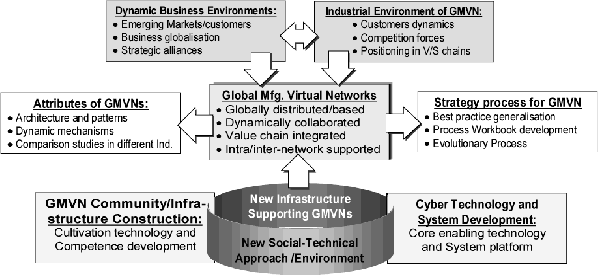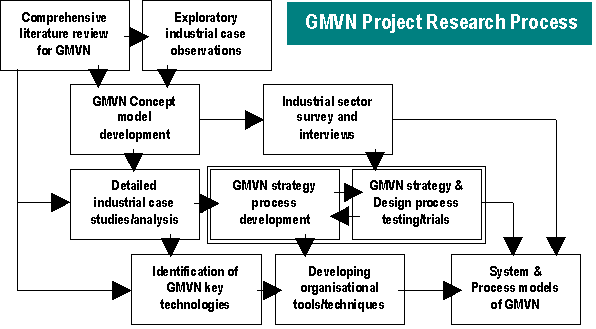Global Manufacturing Virtual Network (GMVN)
Aims
- To understand the changed business and technology environment in which the global manufacturing virtual network (GMVN) are emerging
- To understand the characteristics of global manufacturing virtual networks in terms of structural architectures and dynamic mechanisms
- To develop a strategy process to facilitate analysing business environment and designing global manufacturing virtual networks
- To identify core enabling technology, not only IT techniques but relevant organisational processes to operationalise GMVN
Background
Global manufacturing systems are expected to have much more flexible organisational architectures and operational mechanisms to respond to dramatic changes in the world market. Large improvement at various levels from machine, manufacturing cell, to focused factories and global factory network will of course increase manufacturing flexibility and responsiveness, which is currently manufacturing research emphasis. But a real responsiveness and relevant resource flexibility might come from a dynamic and unlimited resource accessibility rather than a rigid company boundary.
It is inconceivable to operationalise such dynamic and unlimited resource-based manufacturing system under traditional manufacturing and company concepts to organise it globally. Now, markets and competition are seeking an answer, and new technology and strategy enable it, at least in some industrial sectors. It is the time to consider the GMVN more seriously through better observing best practices in the industries and developing theoretical frameworks and practical guide for the new century.
New technology is already changing existing manufacturing systems. Besides globalised e-commerce, manufacturing with its growing knowledge is more and more being operated on internet platform. In conjunction with manufacturing globalisation, strategic alliance, and supply networking, information and cyber technologies are changing manufacturing beyond traditional country and company boundaries. But it will still be some time before it can be fully explored as to how to take advantage of the new technology and transform it to manufacturing competitive advantage.
Research scope
The research work on a new GMVN system includes three main strands.
- GMVN's environments and industrial sectors to clarify the main driving forces for the GMVN emergence.
- Characteristics of GMVN system including its attributes and strategy process developing an effective GMVN.
- Key new technology identification to building and operating GMVNs
The three parts of the research can be demonstrated as three layers in the following figure:

Research approach
The research starts with a comprehensive review of international manufacturing, collaboration strategy, virtual enterprise, and manufacturing paradigms. A series of exploratory and detailed case studies are undertaken in order to identify the attributes and effective processes of GMVN. Based on a better understanding of GMVN, wider sector survey will be conducted to gain a comprehensive picture of GMVN adoption in different industries. Practical strategy and design processes will be developed and tested through action research in collaborated companies. 
Benefits to companies
- A comprehensive picture of GMVN applications and trends in different industrial sectors can be gained through the projectís sector survey and detailed across case analysis
- Better understandings about GMVN attributes, capabilities, architectures and operational mechanisms can be learned through wider case studies in different companies
- General strategy workbook and tailored system design process can be developed to help co-operative companies transform their manufacturing systems towards the Global Manufacturing Virtual Networks
- Relevant tools and techniques can be provided to map strategic alliances and proposition the value and supply chains/flows
- Core technology and infrastructure for GMVNs can be accessed from the research project and collaborative resources
Outcomes
- Map of key drivers for globalisation and virtual networking
- Trends & characteristics of GMVN in key sectors
- Reference models to illustrate structural and dynamic attributes of GMVN
- Strategic framework and design process for GMVN
- Case examples of GMVN design, establishment, operations and evolutions
- Guidelines for the integration of technical and organisational issues
Researchers
Yongjiang Shi
Don Fleet
Mike Gregory
Further information
Yongjiang Shi E: ys@eng.cam.ac.uk









